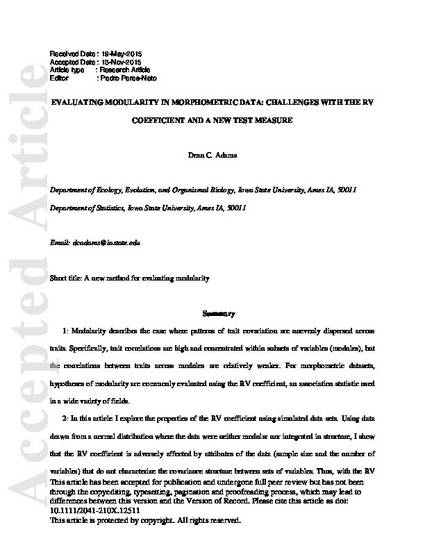
1: Modularity describes the case where patterns of trait covariation are unevenly dispersed across traits. Specifically, trait correlations are high and concentrated within subsets of variables (modules), but the correlations between traits across modules are relatively weaker. For morphometric datasets, hypotheses of modularity are commonly evaluated using the RV coefficient, an association statistic used in a wide variety of fields. 2: In this article I explore the properties of the RV coefficient using simulated data sets. Using data drawn from a normal distribution where the data were neither modular nor integrated in structure, I show that the RV coefficient is adversely affected by attributes of the data (sample size and the number of variables) that do not characterize the covariance structure between sets of variables. Thus, with the RV coefficient, patterns of modularity or integration in data are confounded with trends generated by sample size and the number of variables, which limits biological interpretations and renders comparisons of RV coefficients across datasets uninformative. 3: As an alternative I propose the covariance ratio (CR) for quantifying modular structure, and show that it is unaffected by sample size or the number of variables. Further, statistical tests based on the CR exhibit appropriate type I error rates, and display higher statistical power relative to the RV coefficient when evaluating modular data. 4: Overall, these findings demonstrate that the RV coefficient does not display statistical characteristics suitable for reliable assessment of hypotheses of modular or integrated structure, and therefore should not be used to evaluate these patterns in morphological datasets. By contrast, the covariance ratio meets these criteria and provides a useful alternative method for assessing the degree of modular structure in morphological data.
Available at: http://works.bepress.com/dean-adams/32/

This is the peer reviewed version of the following article: Adams, D.C. 2016. Evaluating modularity in morphometric data: Challenges with the RV coefficient and a new test measure. Methods in Ecology and Evolution. 7:565-572, which has been published in final form at doi: 10.1111/2041-210X.12511. This article may be used for non-commercial purposes in accordance with Wiley Terms and Conditions for Self-Archiving.